|
|
Here are teaching slides for "Geochemical
tests of the snowball earth hypothesis". You can see a full-size version
by clicking on the thumbnail. You can then download that slide individually
by simply dragging it to your desktop.
|
|
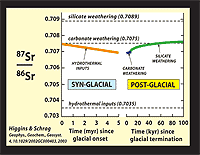 | 11.2:
Geochemical model of the strontium isotopic evolution of seawater over
the course of
a younger Cryogenian snowball earth of 5 Myr duration and its greenhouse
aftermath (Higgins & Schrag, 2003). Input of isotopically conservative
strontium (0.7075), resulting from carbonate diagenesis in response to
rising CO2 (see slide 11-3), muffles the isotopic response to ~0.0005,
which is beyond the resolution of existing data.
|
|
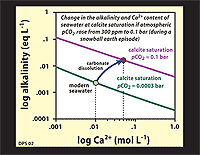 | 11.3:
Changes in alkalinity and calcium ion concentration of modern seawater
if atmospheric CO2 partial pressure rose from present (pre-industrial)
300 ppm to 0.1 bar (100,000 ppm) as suggested by the CO2 hysteresis model
for a snowball earth of Caldeira & Kasting (1993).
|
|
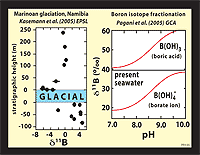 | 11.4:
Boron isotope record (δ11Bcarb) from before and after the younger Cryogenian
(Marinoan) glaciation in one section on the Otavi Group carbonate platform
in northern Namibia (Kasemann et al., 2005). As continental weathering
lowers d11Bcarb and hydrothermal exchange raises it, the δ11Bcarb composition
of seawater is expected to rise over the course of a snowball earth. The
observed lowering of δ11Bcarb is therefore interpreted to be a consequence
of pH lowering associated with CO2 buildup, consistent with the snowball
earth scenario. However, the magnitude of the δ11Bcarb change across the
glacial is problematic, unless the pH of seawater before the glaciation
was higher than present (8.2).
|
|
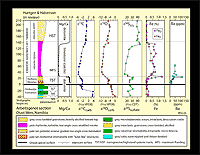 | 11.5:
Multiple proxy records of the younger Cryogenian (Marinoan) cap-carbonate
sequence in the Otavi Group, Namibia.
|
|
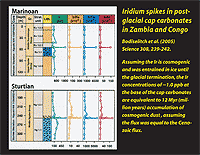 | 11.6:
Part-per-billion concentrations of iridium are found at the base of the
older and younger Cryogenian cap carbonates at different locations in the
Copper Belt of Zambia and southern Congo (Bodiselitch et al., 2005). Elemental
ratios suggest that the Ir spikes are primary and they are hypothesized
to be of extraterrestrial origin because Ir is proportionally more abundant
in interplanetary dust than in Earth’s crust or mantle. Assuming
the spikes represent cosmogenic Ir that was entrained in glacial ice and
released upon deglaciation, the period of entrainment was ~12 Myr assuming
an average Cenozoic Ir flux (Bodiselitch et al., 2005).
|
|
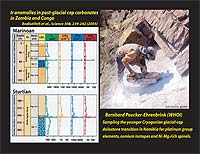 | 11.7:
Bernhard Peucker-Ehrenbrink (Woods Hole Oceanographic Institute) sampling
the younger Cryogenian (Marinoan) glacial and cap dolostone in Namibia,
hoping to replicate the Central African result (Bodiselitch et al., 2005)
and to test its interpretation by analysing the full complement of platinum
group elements, osmium isotopes, and the proportions of nickel- and magnesium-rich
spinels.
|







